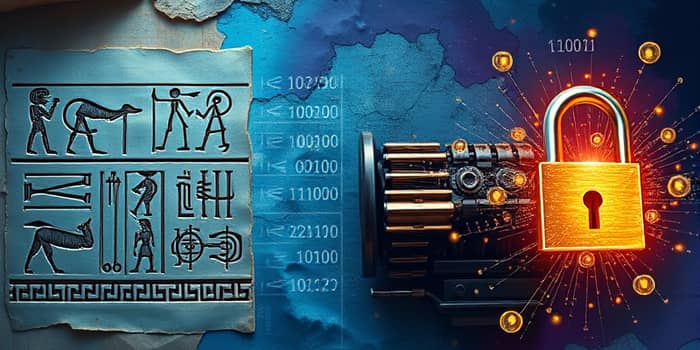In an era where data flows like a river and privacy stands as a sentinel, the story of cryptographic security unfolds across millennia, connecting the distant past with a rapidly approaching quantum future.
This exploration reveals the journey from carved glyphs to quantum-resistant algorithms, illuminating the innovations that have safeguarded human communication through every technological leap.
Through detailed milestones and practical guidance, readers will gain the knowledge to anticipate emerging threats and implement robust security practices in their own environments.
Origins and Ancient Foundations
Since around 1900 BC, cryptographic techniques have been employed to protect the sacred and the secret. Egyptian scribes used non-standard hieroglyphs and hidden messages within tomb inscriptions to ensure only intended recipients could understand sacred texts.
In Greece, the Spartan scytale—a simple wooden staff wrapped with parchment—offered a tangible example of early encryption techniques. Roman leaders later refined substitution ciphers, such as the Caesar Cipher, highlighting how sovereignty and secrecy were intertwined.
These pioneering methods teach us that creativity and adaptability are at the heart of secure communication—an insight that remains valuable when facing today’s digital threats.
19th and 20th Century Milestones
The expansion of telegraph networks in the 19th century created new demand for secrecy. Engineers devised mechanical cipher wheels and rotor machines to obfuscate messages sent across continents.
During World War II, the German Enigma machine epitomized electromechanical encryption. At Bletchley Park, Alan Turing and his team achieved breakthroughs in cryptanalysis, cracking Enigma’s rotating codes and laying the groundwork for modern computers and algorithmic attacks.
These victories underscored the interplay between cipher designers and codebreakers, a dynamic that continues to drive both innovation and vigilance in security today.
Digital Cryptography and Key Innovations
The 1970s marked the dawn of modern digital cryptography. In 1975, IBM’s Data Encryption Standard (DES) became the US government’s certified block cipher. Although its 56-bit key would eventually be outpaced by computing power, DES spawned an entire field dedicated to stronger symmetric algorithms.
Just a year later, the invention of Diffie-Hellman key exchange introduced the world to secure open networks. RSA followed in 1977, enabling encrypted communication without pre-shared secrets, and Elliptic Curve Cryptography (ECC) emerged in 1985, offering equivalent security with smaller key sizes.
Subsequent milestones included Triple DES, IDEA, Skipjack, PGP, DSA, and finally the Advanced Encryption Standard (AES) in 1997, which now underpins countless systems from financial transactions to personal messaging.
Modern Cryptographic Challenges
As digital dependence grew, so did adversaries’ capabilities. In 2004, MD5 suffered practical collision attacks, shattering trust in legacy hash algorithms. By 2005, SHA-1 faced similar vulnerabilities, prompting an urgent move to more secure standards.
The 2013 discovery of an intentional NSA backdoor in Dual_EC_DRBG raised disturbing questions about transparency and governance in cryptographic standards, underscoring the need for open review and collaborative validation.
Quantum Computing’s Threat to Classical Cryptography
Quantum computing introduces both promise and peril. Shor’s algorithm can factor large integers and compute discrete logarithms exponentially faster than classical methods, threatening RSA, Diffie-Hellman, ECC, and DSA.
Hypothetical quantum machines could reduce a task requiring thousands of classical compute-years to mere hours or minutes. Grover’s algorithm accelerates brute force attacks on symmetric ciphers, though doubling key sizes is a practical mitigation.
Transition to Post-Quantum Cryptography
With quantum breakthroughs on the horizon, proactive migration is essential. US federal agencies aim to be quantum-ready by 2035, signaling urgency for all sectors to follow suit.
Current guidance recommends a two-pronged approach: strengthen symmetric key sizes now and adopt emerging quantum-resistant schemes as they mature.
- Lattice-based cryptography for efficient, scalable key exchange
- Code-based algorithms with decades of proven security
- Multivariate and hash-based signatures for data integrity
- Hybrid implementations combining classic and post-quantum ciphers
Governance, Adoption, and Practical Steps
Migrating to new standards demands a systematic strategy. Security teams should conduct comprehensive audits of existing cryptographic deployments, identifying algorithms nearing obsolescence and data at risk of “harvest now, decrypt later” attacks.
Organizations can begin deploying hybrid schemes—pairing classical ciphers with post-quantum algorithms in parallel—to maintain interoperability while building quantum resilience.
- Catalog and classify data by sensitivity and retention period
- Develop phased rollout plans with clear milestones
- Engage vendors on support for quantum-resistant updates
Societal Implications and the Road Ahead
Robust cryptography underpins digital economies, national security, and personal privacy. Breaches erode public trust, trigger financial losses, and destabilize institutions. High-profile leaks—from Snowden’s disclosures to modern ransomware attacks—highlight these stakes.
Global collaboration among standards bodies such as NIST, CRYPTREC, and international consortiums is vital. By prioritizing quantum-resistant designs and fostering transparent governance, the community can safeguard the future of secure communication.
Conclusion
The evolution of cryptographic security illustrates humanity’s quest to protect secrets against ever-evolving threats. From ancient carved symbols to quantum-resistant codes, each innovation has expanded our capacity for trust.
By understanding this rich heritage and implementing proactive, informed strategies—from auditing legacy systems to adopting new standards—organizations and individuals can ensure their data remains secure, today and in the quantum era.
References
- https://www.thalesgroup.com/en/markets/digital-identity-and-security/magazine/brief-history-encryption
- https://threatresearch.ext.hp.com/anticipating-the-quantum-threat-to-cryptography/
- https://en.wikipedia.org/wiki/Timeline_of_cryptography
- https://bpi.com/quantum-computing-the-urgent-need-to-transition-to-quantum-resistant-cryptography/
- https://www.ibm.com/think/topics/cryptography-history
- https://it.umd.edu/security-privacy-audit-risk-and-compliance-services-sparcs/topic-week/quantum-computing-how-it-changes-encryption-we-know-it
- https://nhsjs.com/2024/the-evolution-of-cryptography-and-a-contextual-analysis-of-the-major-modern-schemes/
- https://scienceexchange.caltech.edu/topics/quantum-science-explained/quantum-cryptography










